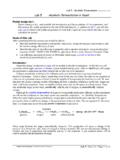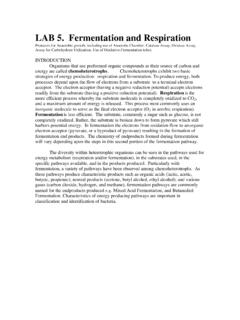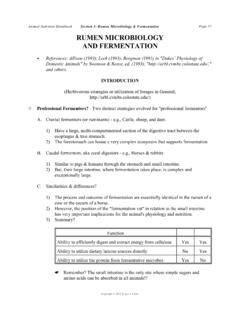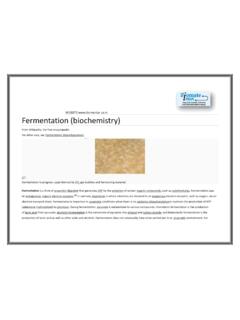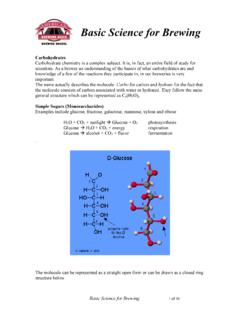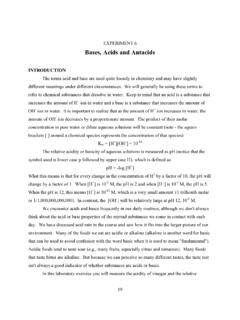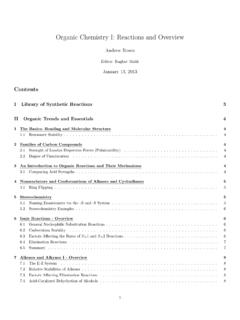Transcription of Lab 5 Sugar Fermentation in Yeast
1 Lab 5. Alcoholic Fermentation (Revised Fall 2009) Adapted from Experiment 12B in Biology with Computers Lab 5 - Biol 211 - Page 1 of 15 Lab 5. Alcoholic Fermentation in Yeast Prelab Assignment Before coming to lab, read carefully the introduction and the procedures of this experiment, and then answer the prelab questions at the end of this lab handout. In addition to lab 5, you will also start Lab 6! Hand in the prelab assignments for both Lab 5 and Lab 6 just before the start of your scheduled lab period.
2 Goals of this Lab After completing this lab exercise you should be able Describe alcoholic Fermentation and aerobic respiration, noting the reactants and products, and the relative energy efficiency of each. Describe the roles of the following in anaerobic and/or aerobic respiration: oxidation/reduction reactions, NAD+, NADH, FAD, FADH, O2, glycolysis, Kreb s cycle, Electron Transport Chain Use a Biology gas pressure sensor to determine which Sugar , sucrose or lactose is best metabolized anaerobically by Yeast .
3 Introduction Anaerobic energy production in Yeast will be studied in this lab investigation. In this lab you will determine which Sugar , sucrose or lactose, is best metabolized by Yeast , while in Part II you will design an experiment to determine the effect ethanol has on the rate of Fermentation . Cultures around the world have for millennia used Yeast Fermentation to produce bread and alcoholic beverages. Yeast is able to metabolize some foods, but not others. In order for an organism to make use of a potential source of food, it must be capable of transporting the food into its cells.
4 It must also have the proper enzymes capable of breaking the food s chemical bonds in a useful way. Sugars are vital to all living organisms. Yeast is capable of using some, but not all sugars as a food source. Yeast can metabolize Sugar in two ways, aerobically, with the aid of oxygen, or anaerobically, without oxygen. Although the aerobic Fermentation of sugars is energetically much more efficient, in this experiment we will set the conditions so that Yeast carries out anaerobic respiration Alcoholic Fermentation .
5 When the Yeast respire glucose aerobically, oxygen gas is consumed at the same rate that CO2 gas is produced there would be no change in the gas pressure in the test tube. The net equation for the more than two dozen steps involved in the aerobic respiration of glucose is: Enzymes C6Hl2O6 (aq) + 6 O2 (g) 6 H2O (l) + 6 CO2 (g) + energy (36-38 ATP + Heat) glucose oxygen water carbon dioxide When Yeast ferments the sugars anaerobically, however, CO2 production will cause a change in the pressure of a closed test tube, since no oxygen is being consumed.
6 We can use this pressure change to monitor the rate of respiration and metabolic activity of the organism. A gas pressure sensor will be used to monitor the Fermentation of Sugar . Lab 5. Alcoholic Fermentation (Revised Fall 2009) Lab 5 - Biol 211 - Page 2 of 15 The alcoholic Fermentation of glucose is described by the following net equation: Enzymes C6Hl2O6 (aq) 2 CH3CH2OH (aq) + 2 CO2 (g) + energy (2 ATP + heat) glucose ethanol carbon dioxide Both alcoholic Fermentation and aerobic respiration are multi-step processes that involve the transfer of energy stored in the chemical bonds of glucose to bonds in adenosine triphosphate, ATP.
7 The energy stored in ATP can then be used to perform cellular work: provide energy for biosynthetic reactions ( growth and repair processes, active transport, etc.). All organisms ( monerans, protists, fungi, plants, and animals) utilize aerobic respiration and/or Fermentation (anaerobic respiration) to produce ATP to power their cellular processes. Note that ethanol is a by-product of alcoholic Fermentation (figure 1). Ethanol, a 2-carbon alcohol, is also known as ethyl alcohol and, less correctly, simply as alcohol.
8 Since Yeast do not have the enzymes needed to metabolize ethanol ( ethanol dehydrogenase and acetaldehyde dehydrogenase), much of the energy stored in the molecules of glucose is trapped in the molecules of ethanol and is unavailable for use by Yeast cells. The complete break down of glucose to carbon dioxide and water in aerobic respiration yields much more energy than does alcoholic Fermentation : 36-38 ATP, versus only 2 ATP molecules produced by anaerobic respiration. Ethanol molecules produced by alcoholic Fermentation diffuse from Yeast cells into the surrounding aqueous environment.
9 Since ethanol is harmful to cellular membranes Yeast cells will die if ethanol concentrations reach a critical level. + 6 O2 Glucose C6H12O6 Aerobic Respiration: with O2 Yeast : 2 CH3CH2OH + 2 CO2 + 2 ATP (Ethanol) Animals: 2 CH3 CHOHCOOH + 2 ATP (Lactic Acid) Most organisms including plants & animals: 6 CO2 + 6 H2 O + 36-38 ATP Anaerobic Respiration: w/o O2 Figure 1. Summary of three of the many possible fates of the 6-carbon Sugar glucose under anaerobic and aerobic conditions.
10 When anaerobic respiration occurs in animals (figure 1) it is known as lactic acid Fermentation since lactic acid, a 3-carbon organic acid is the end product. Like alcoholic Fermentation , lactic acid Fermentation produces only 2 ATP, but lactic acid is the byproduct, not ethanol. Perhaps if ethanol was produced anaerobically in animals more people would take up anaerobic sports such as sprinting and weight lifting!! Since lactic acid production is toxic to cells, anaerobic respiration can only occur for short periods of time in animals.
